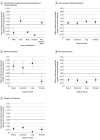Racial and Ethnic Disparities Among Participants in Precision Oncology Clinical Studies
- PMID: 34748007
- PMCID: PMC8576580
- DOI: 10.1001/jamanetworkopen.2021.33205
Racial and Ethnic Disparities Among Participants in Precision Oncology Clinical Studies
Abstract
Importance: Precision oncology is revolutionizing cancer care, allowing for personalized treatments to improve outcomes. Cancer research has benefitted from well-designed studies incorporating precision medicine objectives, but it is unclear if these studies are representative of the diverse cancer population.
Objective: To evaluate racial and ethnic representation in breast, prostate, lung, and colorectal cancer studies incorporating precision oncology objectives in the Clinicaltrials.gov registry and compare with the incidence of these cancer types in racial and ethnic minority groups in the US population.
Design, setting, and participants: This cross-sectional study identified US-based breast, prostate, lung, and colorectal cancer studies incorporating precision oncology objectives for reporting of race and ethnicity. The Surveillance, Epidemiology, and End Results and US Census databases were used to determine cancer incidence by race and ethnicity, linked with cancer type and median year of enrollment for each trial. Data were collected and analyzed between December 2020 and April 2021.
Main outcomes and measures: The expected number of participants per study by each racial and ethnic group was calculated based on the corresponding US-based proportion. Under- and overrepresentation was defined as the ratio of the actual number of enrolled cases to the expected number of cases for each trial by cancer type. Ratios above 1 indicated overrepresentation while a ratio below 1 indicated underrepresentation. Random-effects meta-analysis of representation ratios of individual trials was performed to weigh each individual study.
Results: Of 93 studies encompassing 5867 enrollees with race and ethnicity data; 4826 participants (82.3%) were non-Hispanic White, 587 (10.0%) were Black, and 238 (4.1%) were Asian. Per observed-to-expected ratios, White participants were overrepresented in all studies, with a ratio of 1.35 (95% CI, 1.30-1.37), as well as Asian participants, with a ratio of 1.46 (95% CI, 1.28-1.66), while Black participants (ratio, 0.49; 95% CI, 0.45-0.54), Hispanic participants (ratio, 0.24; 95% CI, 0.20-0.28), and American Indian and Alaskan Native participants (ratio, 0.43; 95% CI, 0.24-0.78) were underrepresented. By individual cancer site, White participants were consistently overrepresented in all studies, while Black and Hispanic participants were underrepresented.
Conclusions and relevance: This analysis found that precision oncology studies for breast, lung, prostate, and colorectal cancers vastly underrepresent racial and ethnic minority populations relative to their cancer incidence in the US population. It is imperative to increase diversity among enrollees so that all individuals may benefit from cancer research breakthroughs and personalized treatments.
Conflict of interest statement
Figures


References
-
- Carrot-Zhang J, Soca-Chafre G, Patterson N, et al. . Genetic ancestry contributes to somatic mutations in lung cancers from admixed Latin American populations. Cancer Discov. 2021;11(3):591-598. doi:10.1158/2159-8290.CD-20-1165 - DOI - PMC - PubMed
-
- Huang FW, Mosquera JM, Garofalo A, et al. . Exome sequencing of African-American prostate cancer reveals loss-of-function ERF mutations. Cancer Discov. 2017;7(9):973-983. doi:10.1158/2159-8290.CD-16-0960 - DOI - PMC - PubMed
MeSH terms
LinkOut - more resources
Full Text Sources
Medical
Miscellaneous

